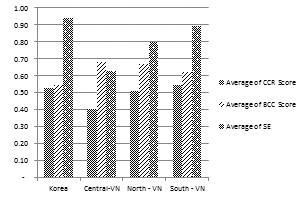1
Almawsheki,
E. S. and
and
Shah,
M. Z.
((2015)), ‚Äú‚ÄúTechnical efficiency analysis of container terminals in the Middle Eastern region‚ÄĚ,‚ÄĚ, The Asian Journal of Shipping andLogistics, Vol. Vol. 31,, pp. pp. 477-486.
2
Banker,
R. D.,
,
Charnes,
A. and
and
Cooper,
W. W.
((1984)), ‚Äú‚ÄúSome models for estimating technical and scale inefficiencies in data envelopment analysis‚ÄĚ,‚ÄĚ, Management Science, Vol. Vol. 30,, pp. pp. 1078-1092.
3
Banker,
R. D.,
,
Charnes,
A.
,
Cooper,
W. W.,
,
Swarts,
J., and
and
Thomas,
D. A.
((1989)), ‚Äú‚ÄúAn introduction to data envelopment analysis with some of its models and their uses‚ÄĚ,‚ÄĚ, Research in Governmental and Nonprofit Accounting, Vol. Vol. 5,, pp. pp. 125-163.
4
Bichou,
K.
((2013)), ‚Äú‚ÄúAn empirical study of the impacts of operating and market condition on container-port efficiency and benchmarking‚ÄĚ,‚ÄĚ, Research in Transportation Economics, Vol. Vol. 42,, pp. pp. 28-37.
5
Charnes,
A.
,
Cooper,
W. W. and
and
Rhodes,
E.
((1978)), ‚Äú‚ÄúMeasuring the efficiency of decision making units‚ÄĚ,‚ÄĚ, European Journal of Operational Research, Vol. Vol. 2,, pp. pp. 429-444.
6
Cooper,
W.W.
,
Seiford,
L.M. and
and
Tone,
K.
((2006)), ‚ÄúIntroduction to data envelopment analysis and its uses: with DEA-solver software and references‚ÄĚ,. Springer Science and Business Media.
7
Cullinane,
K.,
,
Ji,
P. and
and
Wang,
T.-F
((2005a)), ‚Äú‚ÄúThe relationship between privatization and DEA estimates of efficiency in the container port industry‚ÄĚ,‚ÄĚ, Journal of Economics and Business, Vol. Vol. 57,, pp. pp. 433-462.
8
Cullinane,
K.,
,
Wang,
T.-F.,
,
Song,
D.-W. and
and
Ji,
P.
((2006)), ‚Äú‚ÄúThe technical efficiency of container ports: Comparing data envelopment analysis and stochastic frontier‚ÄĚ,‚ÄĚ, Transportation Research Part A, Vol. Vol. 40,, pp. pp. 354-374.
9
Itoh,
H.
((2002),), ‚Äú‚ÄúEfficiency changes at major container ports in Jpan: A window application of data envelopment analysis‚ÄĚ,‚ÄĚ, Review of Urban & Regional Development Studies, Vol. Vol. 14,, pp. pp. 133-152.
10
Martinez-Budria,
E.,
,
Diaz-Armas,
R.,
,
Navarro-Ibanez,
M.
and
Ravelo-Mesa,
T.
((1999),), ‚Äú‚ÄúA study of the efficiency of Spanish port authorities using data envelopment analysis‚ÄĚ,‚ÄĚ, International Journal of Transport Economics, Vol. Vol. 26,, pp. pp. 237-253.
11
Matias,
Herrera Dappe and
and
Ancor,
Suarez-Aleman
(2016)), ‚ÄúCompetitiveness of South Asia‚Äôs Container Ports‚ÄĚ,, The World Bank, number 24333..
12
Nguyen,
H.-O.,
,
Nghiem,
H.-S. and
and
Chang,
Y-T.
((2017),), ‚Äú‚ÄúA regional perpective of port performance using metafrontier analysis: the case study of Vietnamese ports‚ÄĚ,‚ÄĚ, Maritime Economics and Logistics, pp. pp. 1-19.
13
Roll,
Y. and
and
Hayuth,
Y.
((1993),), ‚Äú‚ÄúPort performance comparision applying data envelopment analysis (DEA)‚ÄĚ,‚ÄĚ, Maritime Policy and Management, Vol. Vol. 20,, pp. pp. 153-161.
14
Ryoo,
D. K.
((2005),), ‚Äú‚ÄúA comparative analysis of container terminal operation in Busan and Kwangyang port‚ÄĚ,‚ÄĚ, Journal of Korean Navigation and Port Research, Vol. Vol. 30,, pp. pp. 921-926.
15
Ryoo,
D. K.,
,
Yu,
S. J. and
and
Sharma,
M. J.
((2006),), ‚Äú‚ÄúEfficiency measurement of major container terminal in Asia‚ÄĚ,‚ÄĚ, International Journal of Navigation and Port Research, Vol. Vol. 30,, pp. pp. 267-275.
16
Seo,
Y. J.,
,
Ryoo,
D. K. and
and
Aye,
M. N.
((2012)), ‚Äú‚ÄúAn analysis of container port efficiency in ASEAN‚ÄĚ,‚ÄĚ, Journal of Navigation and Port Research International Edition, Vol. Vol. 36,, pp. pp. 535-544.
17
Tongzon,
J. L.
((2001),), ‚Äú‚ÄúEfficiency measurement of selected Australian and other international ports using data envelopment analysis‚ÄĚ,‚ÄĚ, Transportation Research Part A, Vol. Vol. 35,, pp. pp. 107-122.




 PDF Links
PDF Links PubReader
PubReader Full text via DOI
Full text via DOI Download Citation
Download Citation Print
Print






